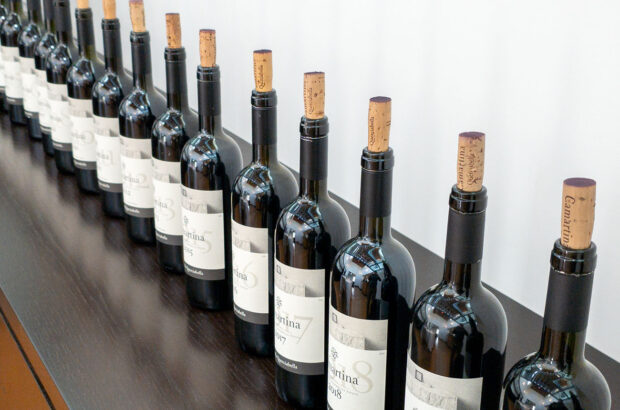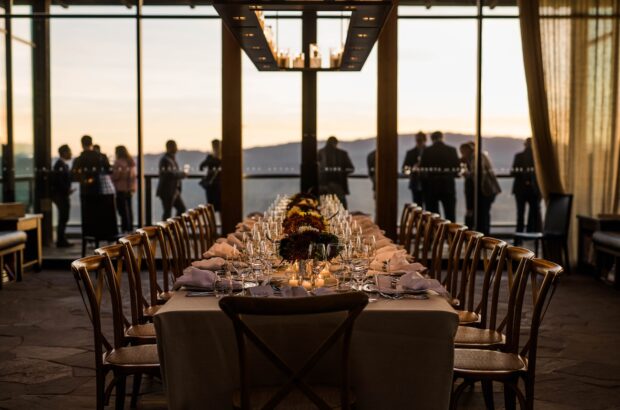Aperitifs take many forms but all provide a very pleasing moment in a drinker’s day.
Simply put, an aperitif is something lovely to drink before we eat. It may be a G&T at a bar after work, Champagne before a glitzy lunch, a killer pre-dinner Martini, or just a humble glass of wine with a packet of salted nuts at home.
How did the trend for aperitifs start?
As with so many things, we have the ancient Romans to thank for the concept of the aperitif. Before embarking on their epic feasts, they’d drink wine mixed with wormwood, a bitter herb thought to aid digestion and cure all manner of gastric ills.
Indeed, the word aperitif derives from the Latin verb aperire, meaning ‘to open’, and has been in use since at least the fifth century. An aperitif is something to open the appetite, stimulate digestion and get us in the mood for a meal that’s to come.
Alcohol itself clears the palate by effectively rinsing pore-clogging molecules from the surface of our tongues, and encourages digestion-aiding salivation.
Bubbles in the form of sparkling wine or a fizzy mixer can have the same effect, while the bitterness found in so many aperitifs is known to release hormones that sharpen our hunger.
But an aperitif is more than just a drink; it’s an occasion in itself, and one that’s particularly European.
In 18th-century Turin, the court of King Victor Amadeus III eschewed rosolio (a traditional rose-scented liqueur) and embraced the first commercially produced vermouth (whose defining ingredient is the Artemisia wormwood family of plants) as their daily aperitivo. This modish custom of socialising with pre-dinner drinks was widely adopted across the continent and endures to this day.
The Gin & Tonic is perhaps the world’s favourite aperitif, with good reason as it deliciously combines alcohol, bubbles, bitterness and a refreshing zest. But when it comes to the choice of aperitifs in Europe, strong regional identities remain.
In northern Italy, vermouth is still the aperitivo of choice in Turin, Piedmont’s capital; while the fashionistas of Milan, in Lombardy, prefer their native Campari.
Pastis is the ‘apéro’ of Marseille, Provence; the Burgundians drink Kir (the local white wine Aligoté mixed with a little crème de cassis); and in southwest France a Pineau des Charentes is more usually proffered at a bar.
Dry Sherry is widespread in southern Spain, but ask for a manzanilla in Barcelona, where they drink local vermouth (called ‘vermut’), and you’re more likely to be served a camomile tea – camomile being the plant from which manzanilla gets its name. Aquavit in Scandinavia, pálinka in Transylvania – the list goes on and on.
These days we have aperitifs at our fingertips from all over the world. You might be at a swanky restaurant or on your sofa; wherever you are, and whatever you’re drinking, the aperitif is a most civilised and civilising habit and deserves due celebration.
Best aperitifs for a decadent lunch: Champagne cocktails

Credit: Sarah Hogan
Who doesn’t love a long and hedonistic lunch? While good Champagne sets a suitable tone as a sybaritic aperitif, Champagne cocktails feel even more racy, and have the advantage of papering over the cracks of more mediocre fizz.
Champagne cocktail
A classic Champagne cocktail is pleasingly ritualistic (and very easy) to make.
- Drop a sugar cube into the bottom of a flute
- Add a few dashes of Angostura bitters (£10 per 20cl in supermarkets)
- Add about 25ml brandy
- Top it up with the wine.
Watch in wonder as the sugar slowly dissolves, and enjoy the frisson as the drink gets stronger towards the bottom of the glass.
French 75
Fresher (but no less invigorating) is a French 75. For two people:
- Mix 70ml, or thereabouts, of gin with 2 tbsp lemon juice and 2 tsp caster sugar until the sugar has dissolved, or use 2 tsp sugar syrup if you have any to hand.
- Add a few cubes of ice
- Stir for 10 seconds or so then strain into a flute
- Top with Champagne and add a twist of lemon zest.
Best aperitifs for Christmas lunch: Sherry

Rejubito. Credit: Sarah Hogan
Most of us have tired of the ‘Sherry is not just for Christmas’ trope that has been around for decades among savvy drinkers, yet Sherry is still woefully underrated. The good news is that this means it remains incredible value for money.
A well-chilled fino or manzanilla has the appetising crispness and savoury appeal that make for a perfect aperitif. Serve chilled in traditional copitas or, as I prefer, a decent wine glass to make the most of the bracing, salty aromas. These dry Sherries go so well with pre-meal nibbles – toasted almonds, of course, or just a humble ready-salted crisp – but they’ll also stand up admirably to more elaborate canapés.
Rebujito
If you prefer to serve a long drink, try a Rebujito – fino Sherry mixed with lemonade (though Spanish lemonade is less sweet than it is in the UK, so I add a splash of soda to compensate) served with ice and garnished with a sprig of mint – though this has a decidedly summery feel.
Substitute the fino for a nutty amontillado or a dry oloroso, and the drink is altogether more suited to winter while still being light and refreshing.
For me, the ideal ratio is two parts Sherry to one each of lemonade and soda, but play around with this according to taste and/or the constitution of your guests. Garnish with a twist of orange peel and maybe a dash of orange bitters to give it extra festive pizzazz.
It’s worth mentioning that amontillado and oloroso are also great with hard cheeses, so can be brought out at the end of the feast as well.
Best aperitifs for an informal supper: Reverse Martini

Reverse Martini. Credit: Sarah Hogan
A classic Dry Martini is one of the world’s great aperitifs, but it’s one I very rarely make myself. I prefer to perch on a stool in a cocktail bar watching the theatre of a skilled bartender mixing dry vermouth with quite a bit more gin (my favoured ratio is 1:5), stirring it over ice for 30 seconds or so and straining it into a beautiful stemmed glass that’s been in a freezer until it’s frosted.
As I drink it, I remind myself of Dorothy Parker’s mantra: ‘I love to drink Martinis, but two at the very most. After three, I’m under the table; after four, I’m under the host.’
Reverse Martini
Far less dangerous, so more fitting for a low-key evening around the kitchen table, is a Reverse Martini, where the ratios of gin and vermouth are swapped around. You can follow the same technique as for the classic, but I recommend a more relaxed approach:
- Put a few ice cubes in a small(ish) tumbler or water glass
- Pour in about 75ml vermouth and a dash of gin
- Stir briefly and serve garnished with a lemon twist, green olive or whatever else takes your fancy, or just in its unadorned simplicity.
- You could also successfully top it up with tonic water to make a longer drink if your guests are thirsty.
Wet Martini
In between, a Wet Martini uses a more balanced ratio of vermouth to gin. Experiment to find your own preferred combination – it’s often 3:1 vermouth to gin but can go up to 1:1, which is also known as a Fifty-Fifty.
An extra-dry vermouth – Noilly Prat (£12-£16 widely available) or similar – is required for the more classic dry Martini, but for a Reverse Martini I might use a slightly sweeter white style. Try Lustau’s brilliant Vermut Blanco (£18.95-£19.95 Berry Bros & Rudd, Philglas & Swiggot, The Oxford Wine Co), or Reus, a Spanish-inspired vermouth from the new The Aperitivo Co (£22).
Best aperitifs for New Year’s Eve: Campari

Bicicletta aperitif. Credit: Sarah Hogan
With its iconically stylish branding, devilish-red colour and thrilling, bittersweet flavour, Campari (£15.50 widely available) smacks of glamour and a good time ahead.
Campari & Soda
A Campari & Soda makes a chic but gentle start to a long, boozy dinner. Details are important in order to get it just right:
- Chill your Campari and soda water in the fridge a few hours ahead
- Serve in tall glasses over ice using one part Campari (50ml at least) to one-and-a-half parts soda
- Garnish with a slice of orange (more traditional) or lemon (I prefer).
The proportions are important to avoid the drink being either too sticky or too washed out, so these are best made for a relatively small gathering.
Bicicletta
More forgiving when it comes to measuring for a larger party is a Bicicletta – a splash of Campari in a crisp white wine (a simple Pinot Grigio would be fine) topped up with a little soda or sparkling water.
You can serve it over ice, but I prefer to chill all the ingredients first and have it without.
Negroni
If you wish to start as you mean to go on in the spirit of debauchery, a Negroni never goes amiss.
Equal parts Campari, sweet red vermouth and a London Dry gin, which you can easily mix ahead of time and chill in bottles in the fridge while you don your glad rags.
Substitute the sweet vermouth for a dry white style and the drink becomes a Cardinale, which is just a little fresher than the classic Negroni. Serve in tumblers on the rocks with a twist of orange, but don’t have too many or you’ll peak too early and miss the midnight bells.
Best aperitifs for a romantic dinner à deux: Pastis

Mauresque cocktail. Credit: Sarah Hogan
There’s something seductive about pastis. The less-bonkers cousin of absinthe (which additionally contains wormwood), it’s the French incarnation of those aniseed-based aperitifs that are found around the eastern shores of the Mediterranean – the Greeks have ouzo; the Turks raki; and in Lebanon and Syria it’s known as arak.
What makes these distinctive is that when water is added to the clear, yellowish liquid, the drink becomes, almost magically, a cloudy milky white, or louche, as the French so fittingly call it.
The traditional method
The traditional way to drink pastis is to pour 50ml or so into a tallish glass and serve with a jug of chilled water alongside to dilute according to taste – four or five parts of water to one of pastis is about right for me, but it’s fun to play around to find your own sweet spot where the drink opens up to become refreshing but still very appetising. Ice is an optional extra.
Mauresque cocktail
A Mauresque cocktail raises pastis to an altogether higher level, adding the gentle sweetness and nuttiness of orgeat (almond-flavoured syrup) to the intensely pungent and savoury notes of pastis.
- Simply mix about 50ml pastis with 25ml orgeat
- Add a few ice cubes and enough chilled water – about 100ml – till you reach your own perfect balance.
- Black olives and/or anchovies make a great food match before you move on to the main event.











